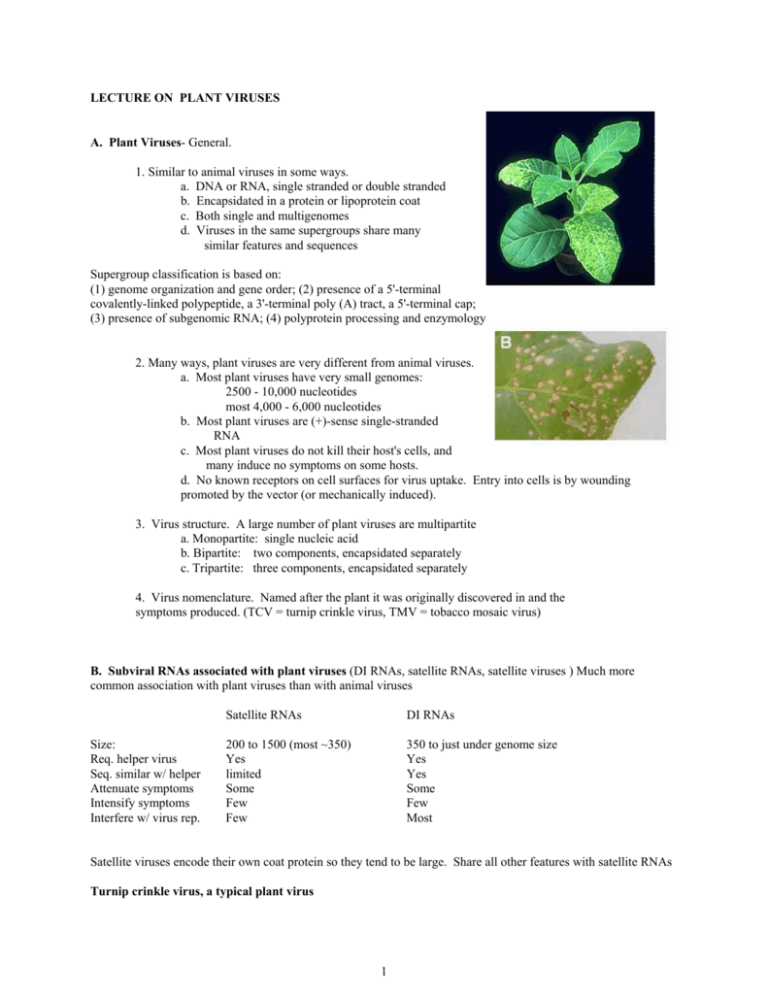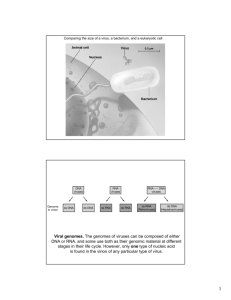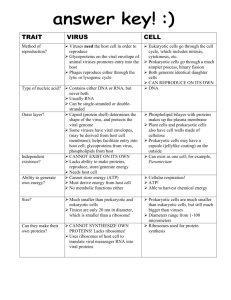LECTURE ON PLANT VIRUS REPLICATION (5/6/97)
advertisement

LECTURE ON PLANT VIRUSES A. Plant Viruses- General. 1. Similar to animal viruses in some ways. a. DNA or RNA, single stranded or double stranded b. Encapsidated in a protein or lipoprotein coat c. Both single and multigenomes d. Viruses in the same supergroups share many similar features and sequences Supergroup classification is based on: (1) genome organization and gene order; (2) presence of a 5'-terminal covalently-linked polypeptide, a 3'-terminal poly (A) tract, a 5'-terminal cap; (3) presence of subgenomic RNA; (4) polyprotein processing and enzymology 2. Many ways, plant viruses are very different from animal viruses. a. Most plant viruses have very small genomes: 2500 - 10,000 nucleotides most 4,000 - 6,000 nucleotides b. Most plant viruses are (+)-sense single-stranded RNA c. Most plant viruses do not kill their host's cells, and many induce no symptoms on some hosts. d. No known receptors on cell surfaces for virus uptake. Entry into cells is by wounding promoted by the vector (or mechanically induced). 3. Virus structure. A large number of plant viruses are multipartite a. Monopartite: single nucleic acid b. Bipartite: two components, encapsidated separately c. Tripartite: three components, encapsidated separately 4. Virus nomenclature. Named after the plant it was originally discovered in and the symptoms produced. (TCV = turnip crinkle virus, TMV = tobacco mosaic virus) B. Subviral RNAs associated with plant viruses (DI RNAs, satellite RNAs, satellite viruses ) Much more common association with plant viruses than with animal viruses Size: Req. helper virus Seq. similar w/ helper Attenuate symptoms Intensify symptoms Interfere w/ virus rep. Satellite RNAs DI RNAs 200 to 1500 (most ~350) Yes limited Some Few Few 350 to just under genome size Yes Yes Some Few Most Satellite viruses encode their own coat protein so they tend to be large. Share all other features with satellite RNAs Turnip crinkle virus, a typical plant virus 1 RNAs associated wit h Turnip crink le virus p88 (RdRp) p28 TCV genomic RNA p8 4054 b p9 p8 CP 1721 b p9 CP 1447 b Two subgenomic RNAs CP 4054 b TCV genomic RNA 194 b satD TCV subviral RNAs satC and satD are satellite RNAs 356 b satC SatC enhances the symptoms of TCV (how it does this will be explained at the end of the talk) Mock Mock TCV + satD + satC TCV + satC B. Plant virus entry and movement between cells (a major difference with animal viruses). There are no receptors for plant viruses. Entry into cells requires a specific vector (usually an insect or beetle) which feeds on an infected plant and transmits the virus (must break through the cell wall). To move from cell-to-cell, plant viruses encode special proteins (movement proteins) that allow the viruses to move through plants Two types of movement: Cell-to-cell (through plasmodesmata) and long distance (through vascular system) 2 Plant vascular system The green color is an indicator of where the virus is located Movement proteins move themselves and specific viral RNAs through plasmodesmata Movement proteins modify plasmodesmata, making them larger. However, only older plasmodesmata are enlarged and not in all cell types. Viruses move through young plasmodesmata (this confuses us too) Movement proteins are RNA binding proteins that bind the viral genome and target it to plasmodesmata using the cell's cytoskeleton. Phosphorylation/dephosphorylation of the movement protein may also be important Plant viruses move in many different forms: Some viruses require coat protein for cell-to-cell/long distance movement Others require coat protein only for long distance movement Others don’t require coat protein for movement Some require coat protein but not virion formation Some require virions, but virions only form in certain cell types (just prior to entry into the vascular system) p28 p88 (RdRp) p8 p9 p8 and p9 are the TCV movement proteins. CP TCV requires its coat protein to move long distances (but not for cell-to-cell movement). It does not require virions for movement TCV genomic RNA Some movement proteins form tubular structures through which virions move Microtubules and microfilaments appear to be involved in intracellular trafficking of the virus to the plasmodesmata (still controversial) C. Origin of movement proteins Endogenous system for the transport of proteins and nucleic acids 1. Transcription factors Knotted 1 (25 kDa) and its mRNA 2. Polypeptides like systemin (18 aa) (inducer of defense-related genes) 3. Signaling RNAs involved in gene silencing (a plant defense system, see below) 3 4. mRNAs. Probably a number of RNAs traffic through the phloem 5. Using homology to plant movement protein, Lucas group found an endogenous plant protein that helps to traffic RNAs. So movement proteins were probably plant proteins acquired by plant viruses to help them move. D. The RNA silencing plant defense system Plant viruses must suppress the silencing defensive system to establish a systemic infection Virus enters cell Some (all?) plant viruses (and some animal viruses) encode suppressors of RNA silencing Small interfering RNAs are 21 to 25 nt long Different proteins interfere with different steps in the pathway virus ? p28 p88 (RdRp) p8 p9 CP TCV genomic RNA Systemic signal that induces silencing in systemic tissue The TCV suppressor of RNA silencing is the coat protein (CP) TCV CP is a very strong suppressor by itself TCV CP suppresses a very early step in the RNA silencing process. It binds to dicer enzyme and inactivates it CP 180 TCV capsid In the context of the virus it is a weak suppressor (it is needed early but it is synthesized late) 180 subunits of the CP are used to make the viral capsid. In this form, the CP cannot suppress RNA silencing. So there is little free CP to suppress silencing How does the satellite RNA of TCV cause such severe symptoms? Mock TCV TCV + satC SatC interferes with the ability of the CP to form virions. Then there is more free CP to disable RNA silencing allowing the virus to move more rapidly through the plant. Leads to greater symptoms and plant death. 4







